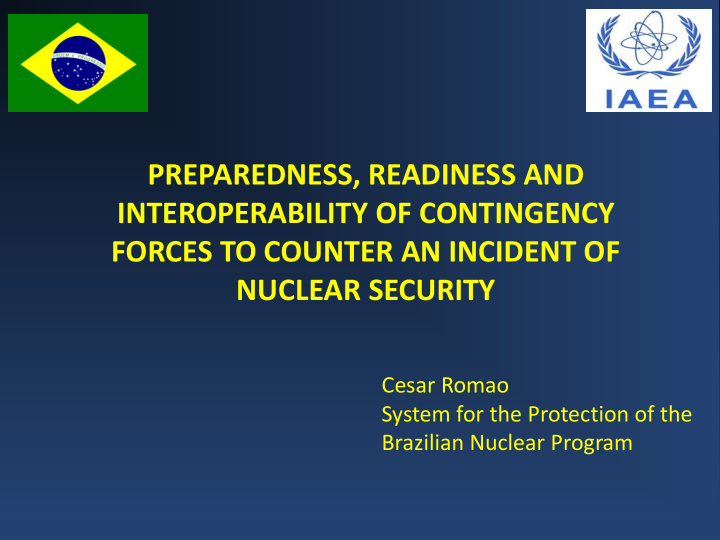



PREPAREDNESS, READINESS AND INTEROPERABILITY OF CONTINGENCY FORCES TO COUNTER AN INCIDENT OF NUCLEAR SECURITY Cesar Romao System for the Protection of the Brazilian Nuclear Program
Physical Protection System Process
Amendment to the CPPNM Fundamental Principles Principle “K”: Contingency Plans. The employment of a security force should be based on a contingency planning, which should be the goal of the preparedness and readiness processes. Principle “G”: Threat. A Physical Protection System should be able to effectively confront a threat assessment or a Design Basis Threat (DBT).
OPERATOR CONTINGENCY PLAN - Concept of Operations to timely interrupt a malicious act. - Important part of a facility’s ability to successfully resolve an incident of nuclear security. - Integration between the contingency planning and the emergency planning. - State and operator planning integration in separate plans. - The State Plan should complement the operator’s Plan.
STATE CONTINGENCY PLAN - Purpose of a State Contingency Plan: - defeat a threat with capability beyond the Design Basis Threat or a threat assessment; and - When the level of uncertainty is high, only the State can assure a minimal control.
STATE CONTINGENCY PLAN - Interagency operation: - operational command - centralized planning X decentralized execution - general, flexible and proactive - effective notification system and command structure - deliberate planning (prepared in a non crisis situation) based on a scenario - triggered without delay - scaled response - necessary resources
Fundamentals of building capabilities • Design Basis Threat - Induces the necessary capabilities of a Physical Protection System • Capability-Based Planning to build nuclear security forces - what operative capabilities should be necessary to be developed?
Training Programs - standartization - current nuclear security scenario evaluation - training objetives - training cycle - guidance for drills, tabletops exercises, full scale exercises - recommendations - available budget
Exercises and drills fundamentals - Purpose of exercises: validate plans - Scenario with two parties representation - Integration between safety X security - Force on Force exercises - Assignment of umpires - Best practices and lesson learned - After Action Reviews - Evaluation System
SIMULATION Virtual Live Constructive
READINESS - Notification of the operator response force - Depends on the effectiveness of detection and delay - Notification of a State response force - Threat beyond DBT - It may be considered a terrorist attack - Depends on reliable and robust Inteligence to increase the Readiness and promptly intervene - Without enough Inteligence, State response force may not be immediately available
Deployment of response forces - In-site response force: already deployed - Response after intrusion detection and assessment - Off-site (local police): On request - may depend on availability - Off-site: (National Plan): On request - demands high resources of the State
READINESS - Operational Command - ideal: formal command structure - no command structure: cooperation is key - unity of effort - Interoperability - facilitates reinforcement - speeds up joint operations - Simplicity: clear, uncomplicated plans and concise orders
SUMMARY Contingency Planning X Preparedness X Readiness X Interoperability Cesar Romao cesar.romao@presidencia.gov.br
Recommend
More recommend